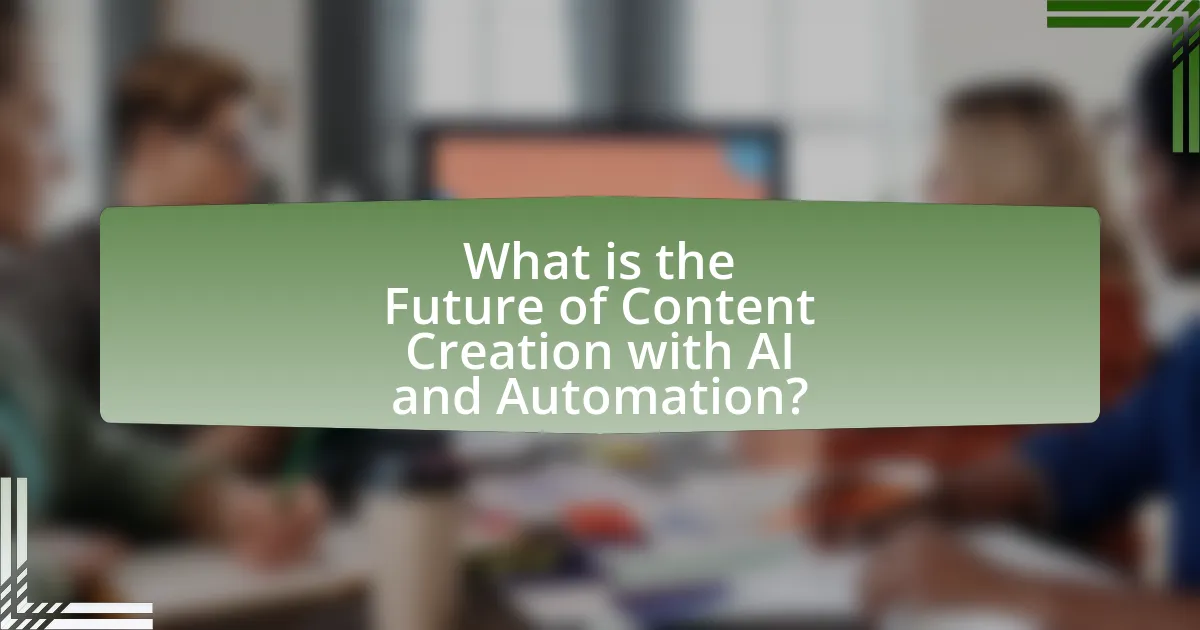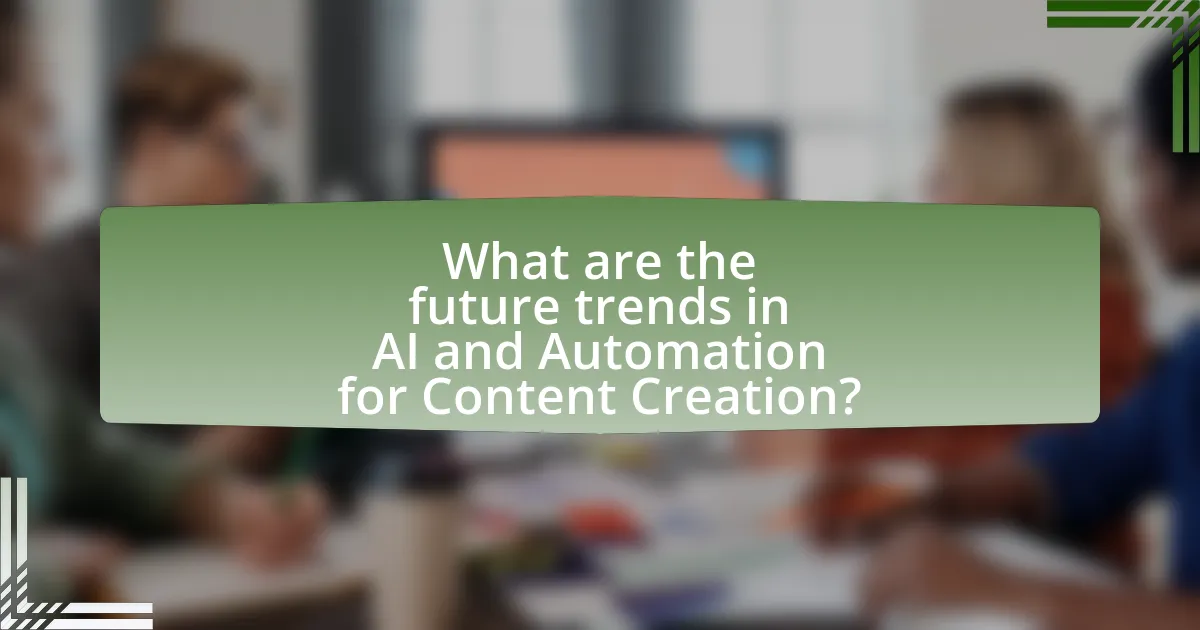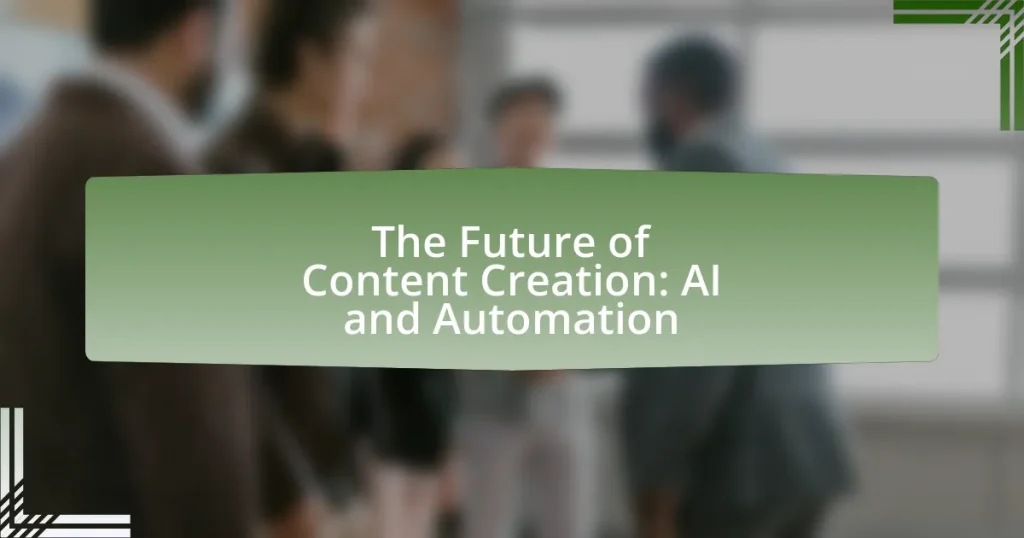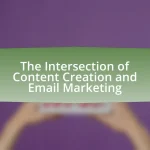The article explores the future of content creation through the lens of artificial intelligence (AI) and automation, highlighting their roles in enhancing efficiency, personalization, and scalability. It discusses how AI technologies, such as natural language processing and machine learning, are transforming content production by enabling rapid generation of high-quality material while allowing for tailored audience engagement. Key technologies driving this change include natural language generation and generative adversarial networks, which improve both the quality and creativity of content. The article also addresses the implications of these advancements for content creators, including the need for new skills, ethical considerations, and the potential impact on job roles within the industry.

What is the Future of Content Creation with AI and Automation?
The future of content creation with AI and automation is characterized by increased efficiency, personalization, and scalability. AI technologies, such as natural language processing and machine learning, enable creators to generate high-quality content rapidly, reducing the time and effort traditionally required. For instance, tools like OpenAI’s GPT-3 can produce articles, marketing copy, and social media posts in a fraction of the time it takes a human writer.
Moreover, automation allows for the analysis of audience preferences and behavior, enabling tailored content that resonates more effectively with target demographics. According to a report by McKinsey, companies that leverage AI in their content strategies can see productivity improvements of up to 40%. This integration of AI and automation not only streamlines the content creation process but also enhances engagement and conversion rates, making it a pivotal aspect of future marketing and communication strategies.
How is AI transforming the landscape of content creation?
AI is transforming the landscape of content creation by automating processes, enhancing personalization, and improving efficiency. Automation tools powered by AI, such as natural language generation and image recognition, enable creators to produce high-quality content at a faster rate. For instance, platforms like OpenAI’s GPT-3 can generate articles, blogs, and marketing copy with minimal human intervention, significantly reducing the time required for content development. Additionally, AI algorithms analyze user data to tailor content to specific audiences, increasing engagement and relevance. According to a report by McKinsey, companies that leverage AI in content creation can see productivity improvements of up to 40%. This shift not only streamlines workflows but also allows creators to focus on strategic tasks, ultimately reshaping the content creation landscape.
What specific technologies are driving AI in content creation?
Natural Language Processing (NLP), machine learning algorithms, and generative adversarial networks (GANs) are the specific technologies driving AI in content creation. NLP enables machines to understand and generate human language, facilitating tasks such as text generation and sentiment analysis. Machine learning algorithms analyze vast datasets to identify patterns and improve content relevance and personalization. GANs, on the other hand, are used to create realistic images and videos by training two neural networks against each other, enhancing visual content quality. These technologies collectively enhance the efficiency, creativity, and personalization of content creation processes.
How does AI enhance creativity in content production?
AI enhances creativity in content production by providing tools that automate repetitive tasks, generate ideas, and analyze audience preferences. These capabilities allow creators to focus on higher-level creative processes rather than mundane details. For instance, AI algorithms can analyze vast amounts of data to identify trending topics, enabling content creators to produce relevant and engaging material. Additionally, AI-driven platforms like OpenAI’s GPT-3 can assist in generating text, brainstorming concepts, and even suggesting improvements, thereby expanding the creative possibilities for writers and marketers. Studies have shown that integrating AI in content workflows can lead to a 30% increase in productivity, allowing creators to explore innovative ideas more freely.
What role does automation play in content creation?
Automation significantly enhances content creation by streamlining processes, improving efficiency, and enabling scalability. It allows creators to generate, edit, and distribute content more rapidly, reducing the time spent on repetitive tasks. For instance, tools like natural language generation software can produce articles and reports in minutes, which traditionally would take hours or days. According to a study by the Content Marketing Institute, 70% of marketers believe that automation helps them save time and resources, allowing them to focus on strategy and creativity. This integration of automation not only increases productivity but also ensures consistency in content quality and delivery.
How does automation streamline the content creation process?
Automation streamlines the content creation process by enhancing efficiency and reducing manual effort. By utilizing tools such as AI-driven writing assistants, content scheduling software, and automated editing programs, creators can produce high-quality content faster and with fewer resources. For instance, a study by the Content Marketing Institute found that organizations using automation tools can increase their content output by up to 50%, allowing teams to focus on strategy and creativity rather than repetitive tasks. This shift not only accelerates production timelines but also improves consistency and accuracy in content delivery.
What are the limitations of automation in content creation?
Automation in content creation has several limitations, including a lack of creativity, inability to understand context, and challenges in producing high-quality, nuanced content. While automation can efficiently generate text based on algorithms and data patterns, it often fails to replicate the human touch necessary for engaging storytelling or emotional resonance. Research indicates that automated systems struggle with context comprehension, leading to content that may be factually correct but lacks depth or relevance. For instance, a study by the Content Marketing Institute found that 70% of marketers believe that human creativity is essential for effective content, highlighting the inadequacy of automation in fully replacing human input. Additionally, automated content can sometimes produce repetitive or generic outputs, which can diminish audience engagement and brand authenticity.

What are the implications of AI and Automation for Content Creators?
AI and automation significantly impact content creators by enhancing efficiency and enabling personalized content generation. These technologies allow creators to automate repetitive tasks, such as editing and scheduling, which can lead to increased productivity. For instance, tools like Grammarly and Adobe Sensei utilize AI to improve writing and editing processes, allowing creators to focus on more strategic aspects of content development. Additionally, AI-driven analytics can provide insights into audience preferences, enabling creators to tailor their content more effectively. According to a report by McKinsey, automation can increase productivity by up to 40%, demonstrating the potential for AI to transform content creation workflows.
How will AI and automation affect job roles in content creation?
AI and automation will significantly transform job roles in content creation by streamlining processes and enhancing productivity. Content creators will increasingly rely on AI tools for tasks such as generating ideas, drafting articles, and optimizing content for SEO, which can lead to a reduction in the demand for traditional writing roles. According to a report by McKinsey, up to 30% of tasks in content creation can be automated, allowing human creators to focus on strategy, creativity, and nuanced storytelling that AI cannot replicate. This shift will necessitate new skill sets, emphasizing the need for content professionals to adapt to technological advancements and integrate AI into their workflows effectively.
What new skills will content creators need to thrive?
Content creators will need to develop skills in AI literacy, data analytics, and multimedia production to thrive. AI literacy enables creators to leverage tools like natural language processing and machine learning for content optimization and audience engagement. Data analytics skills allow creators to interpret audience metrics and tailor content strategies effectively, as evidenced by a 2022 report from HubSpot indicating that data-driven content strategies can increase engagement by up to 30%. Additionally, proficiency in multimedia production, including video editing and graphic design, is essential as platforms increasingly favor diverse content formats, with video content projected to account for 82% of all online traffic by 2025 according to Cisco.
How can content creators adapt to the rise of AI tools?
Content creators can adapt to the rise of AI tools by integrating these technologies into their workflows to enhance productivity and creativity. By utilizing AI for tasks such as content generation, data analysis, and audience engagement, creators can streamline their processes and focus on higher-level creative work. For instance, a study by McKinsey & Company indicates that AI can automate up to 30% of tasks in various industries, allowing creators to allocate more time to strategy and innovation. Additionally, embracing AI tools for personalized content recommendations can improve audience targeting, leading to increased engagement and retention.
What ethical considerations arise from AI in content creation?
Ethical considerations arising from AI in content creation include issues of authorship, bias, misinformation, and the potential for job displacement. Authorship concerns stem from the ambiguity of crediting AI-generated content, raising questions about intellectual property rights. Bias in AI algorithms can lead to the perpetuation of stereotypes or exclusion of diverse perspectives, as evidenced by studies showing that AI systems often reflect the biases present in their training data. Misinformation is another critical issue, as AI can generate content that appears credible but is factually incorrect, complicating the landscape of trust in information sources. Finally, the automation of content creation poses a risk of job displacement for human creators, as AI tools become capable of producing high-quality content at scale, potentially undermining traditional roles in the creative industries.
How does AI impact originality and copyright in content?
AI significantly impacts originality and copyright in content by generating material that can mimic human creativity, raising questions about authorship and ownership. As AI systems analyze vast datasets to produce text, images, or music, they often create outputs that resemble existing works, which can lead to potential copyright infringement. For instance, the U.S. Copyright Office has stated that works created solely by AI without human intervention may not qualify for copyright protection, emphasizing the need for human authorship to establish originality. This evolving landscape necessitates new legal frameworks to address the complexities of AI-generated content and its implications for intellectual property rights.
What are the potential biases in AI-generated content?
AI-generated content can exhibit several potential biases, primarily stemming from the data used to train the models. These biases include representation bias, where certain demographics or viewpoints are underrepresented, leading to skewed outputs. Additionally, confirmation bias may occur, as AI systems can reinforce existing stereotypes or beliefs present in the training data. A study by the AI Now Institute highlights that biased training datasets can result in discriminatory outcomes, particularly in sensitive areas like hiring or law enforcement. Furthermore, algorithmic bias can arise from the design of the AI itself, where the model’s architecture may favor certain patterns over others. These biases can significantly impact the reliability and fairness of AI-generated content.

What are the future trends in AI and Automation for Content Creation?
Future trends in AI and automation for content creation include increased personalization, enhanced collaboration between humans and AI, and the rise of generative AI tools. Personalization will allow content to be tailored to individual user preferences, improving engagement and relevance. Enhanced collaboration will see AI acting as a co-creator, assisting writers and marketers in generating ideas and optimizing content strategies. The rise of generative AI tools, such as OpenAI’s GPT models, will enable faster content production and diverse formats, including text, images, and video. These trends are supported by the growing adoption of AI technologies in various industries, with a report from McKinsey indicating that 50% of companies are integrating AI into their operations, highlighting the shift towards automation in content creation.
What emerging technologies should content creators watch for?
Content creators should watch for artificial intelligence, augmented reality, and blockchain technology. Artificial intelligence enhances content creation through tools that automate editing, generate text, and analyze audience engagement, significantly improving efficiency and creativity. Augmented reality offers immersive experiences, allowing creators to engage audiences in innovative ways, such as interactive storytelling and virtual events. Blockchain technology provides solutions for copyright protection and monetization, enabling creators to securely distribute their work and receive fair compensation. These technologies are reshaping the landscape of content creation, making it essential for creators to stay informed and adapt.
How will advancements in AI change audience engagement?
Advancements in AI will significantly enhance audience engagement by enabling personalized content delivery and real-time interaction. AI algorithms analyze user data to tailor experiences, ensuring that content resonates with individual preferences. For instance, platforms like Netflix and Spotify utilize AI to recommend shows and music based on user behavior, leading to increased viewer retention and satisfaction. Additionally, AI-driven chatbots facilitate immediate responses to audience inquiries, fostering a more interactive and engaging environment. Research indicates that personalized marketing can increase conversion rates by up to 202%, demonstrating the effectiveness of AI in enhancing audience engagement.
What role will data analytics play in future content strategies?
Data analytics will be crucial in shaping future content strategies by enabling data-driven decision-making. By analyzing audience behavior, preferences, and engagement metrics, content creators can tailor their strategies to meet specific audience needs. For instance, a study by HubSpot found that companies using data analytics in their content strategies saw a 20% increase in engagement rates. This demonstrates that leveraging data analytics not only enhances content relevance but also improves overall performance, ensuring that content resonates with target audiences effectively.
How can content creators leverage AI and automation effectively?
Content creators can leverage AI and automation effectively by utilizing tools that enhance content generation, optimize distribution, and analyze audience engagement. For instance, AI-driven platforms like Jasper and Copy.ai assist in generating high-quality written content quickly, allowing creators to focus on strategy and creativity. Automation tools such as Hootsuite and Buffer enable efficient scheduling and posting across multiple social media channels, ensuring consistent audience engagement. Additionally, analytics tools powered by AI, like Google Analytics and HubSpot, provide insights into audience behavior, helping creators tailor their content to meet viewer preferences. These applications demonstrate that integrating AI and automation can significantly streamline workflows and improve content effectiveness.
What best practices should be followed when using AI tools?
When using AI tools, best practices include ensuring data privacy, validating AI-generated content, and maintaining human oversight. Data privacy is crucial; organizations must comply with regulations like GDPR to protect user information. Validating AI-generated content involves cross-checking facts and ensuring accuracy, as studies show that AI can produce misleading information. Maintaining human oversight is essential to guide AI decisions and ensure ethical use, as human judgment is necessary to interpret context and nuance that AI may miss.
How can creators balance automation with personal touch in content?
Creators can balance automation with a personal touch in content by strategically using automated tools for efficiency while ensuring that personal insights and unique perspectives are integrated into the final output. For instance, creators can utilize AI-driven analytics to understand audience preferences and trends, which allows them to tailor their content more effectively. Additionally, incorporating personal anecdotes or experiences into automated content can enhance relatability and engagement. Research shows that personalized content can increase audience interaction by up to 50%, demonstrating the effectiveness of this approach.
What practical tips can enhance the use of AI in content creation?
To enhance the use of AI in content creation, implement structured prompts that guide the AI in generating relevant and coherent content. Structured prompts help the AI understand context and desired outcomes, leading to higher quality outputs. For instance, specifying the target audience, tone, and key points can significantly improve the relevance of the generated content. Research shows that well-defined prompts can increase the effectiveness of AI models by up to 30%, as they reduce ambiguity and focus the AI’s capabilities on specific tasks.




